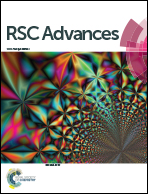Protein–calcium phosphate nanocomposites: benchmarking protein loading via physical and chemical modifications against co-precipitation†
Abstract
The low protein loading capacity of commercially available calcium phosphate (CaP) is a major impediment in effectively using this inorganic material as a protein carrier despite its recognized biocompatibility. In this study, nanocomposites of CaP and BSA were prepared by carefully designed precipitation methods in aqueous media. In the first co-precipitation method (CaP–BSA-1), calcium and phosphate precursors were simultaneously added to the protein solution matrix and in the second method (CaP–BSA-2) the protein solution was added after the reaction of the precursors. The crystallinity and phase composition of the resulting powders were determined using an X-ray diffraction technique. Qualitative confirmation of the presence of BSA on the nanocomposites, was obtained using mass spectrometry, ATR-FTIR and XPS. The results from desorption and thermogravimetric measurements indicated that BSA was trapped inside the cavities in the case of CaP–BSA-1 whereas it was mostly surface adsorbed in the case of CaP–BSA-2. The protein loading capacity of these composites was compared with various physical and chemical surface modification strategies used on commercially available calcium phosphate powders. Nanocomposite particulates were found to have about 275% higher protein loading capacity as compared to a commercial CaP powder with the same surface area. Overall, this study benchmarks the different techniques used for protein loading enhancement on inorganic materials.


 Please wait while we load your content...
Please wait while we load your content...